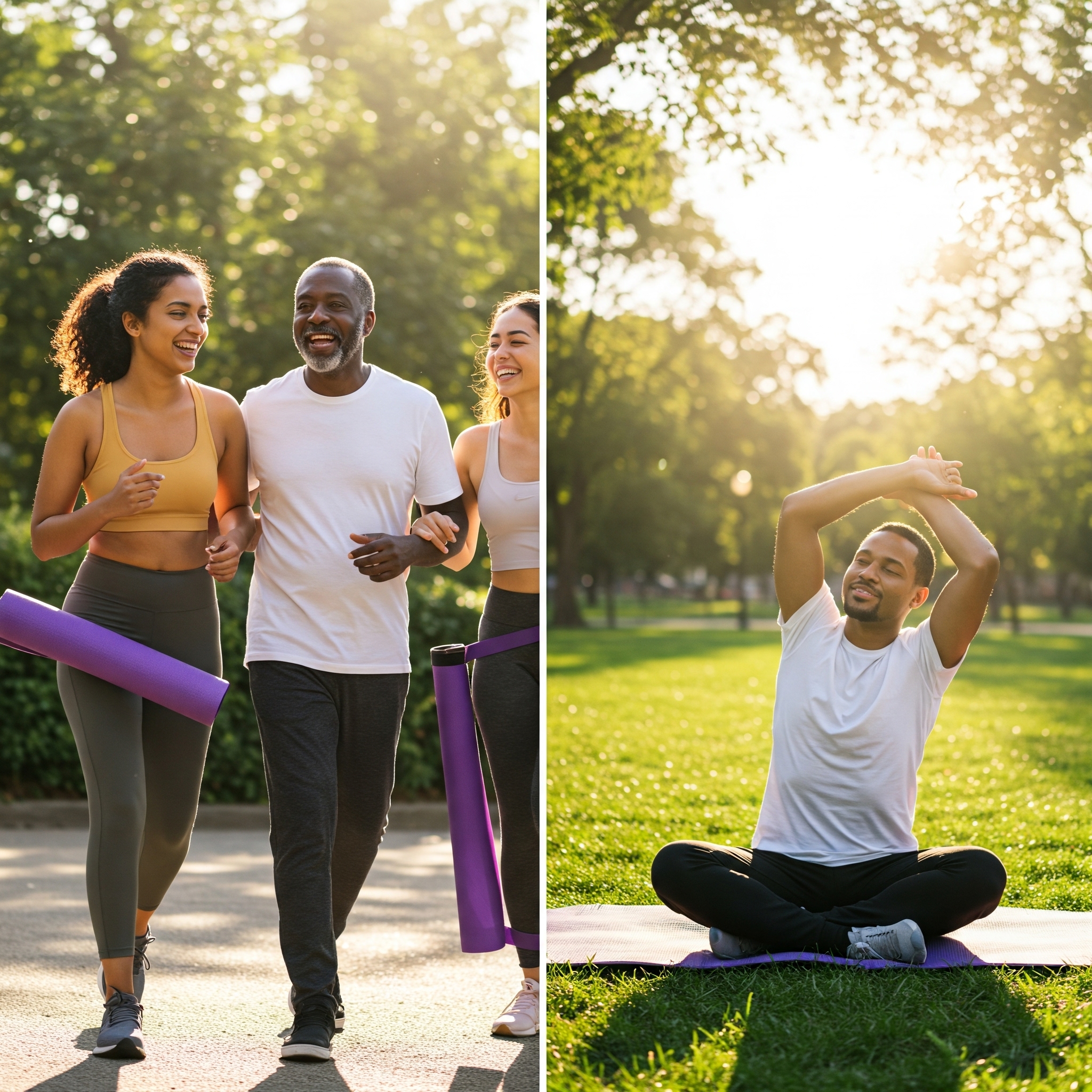10 Simple Mindfulness Exercises to Reduce Stress & Anxiety in Under 10 Minutes a Day
In the whirlwind of our hyper-connected lives in 2025, stress and anxiety often feel like unwelcome daily companions. The constant demands, digital overload, and fast pace can leave us feeling overwhelmed and disconnected. But what if you could reclaim moments of calm and cultivate inner peace in just a few minutes a day? Enter mindfulness – a powerful, accessible practice that offers scientifically-backed mental wellness tips and anxiety relief techniques. This guide provides 10 simple mindfulness exercises you can do in under 10 minutes to reduce stress and enhance your well-being.
What is Mindfulness? (And Why It Matters)
Mindfulness, at its core, is the practice of paying attention to the present moment – your thoughts, feelings, bodily sensations, and the surrounding environment – with curiosity and without judgment. It's about being aware, rather than being swept away by the constant stream of thoughts or worries about the past and future.
The benefits of mindfulness are increasingly supported by scientific research. Studies have shown its effectiveness in:
- Reducing stress and anxiety levels
- Improving focus and concentration
- Enhancing emotional regulation
- Promoting better sleep
- Increasing self-awareness and compassion
Learning how to practice mindfulness doesn't require hours of meditation or a silent retreat (though those can be beneficial too!). Simple, short exercises can make a significant difference.
Your Toolkit for Calm: 10 Simple Mindfulness Exercises (Under 10 Minutes Each)
Here are 10 distinct mindfulness exercises you can easily incorporate into your day for quick stress relief exercises:
Mindful Breathing (Breath Awareness)
- How to Do It: Find a comfortable position (sitting or lying down). Gently close your eyes or soften your gaze. Bring your attention to your breath. Notice the sensation of the air entering your nostrils, filling your lungs, and then leaving your body. Don't try to change your breathing; just observe its natural rhythm. If your mind wanders (and it will!), gently guide it back to your breath.
- Time Commitment: 2-5 minutes.
- Specific Benefits: Calms the nervous system, reduces heart rate, and anchors you in the present moment. Excellent for immediate stress reduction.
Body Scan Meditation
- How to Do It: Lie down comfortably. Starting from your toes, slowly bring your attention to each part of your body, one by one, moving up to the crown of your head. Notice any sensations (warmth, coolness, tingling, tension, relaxation) without judgment. If you don't feel anything in a particular area, that's okay too.
- Time Commitment: 5-10 minutes.
- Specific Benefits: Increases body awareness, helps release physical tension you might not be aware of, and promotes deep relaxation.
Mindful Walking
- How to Do It: Whether you're walking to work, in a park, or even just down a hallway, bring your full attention to the experience of walking. Notice the sensation of your feet touching the ground, the movement of your legs and arms, the rhythm of your steps, and the sights and sounds around you.
- Time Commitment: 5-10 minutes (or longer, as part of your routine).
- Specific Benefits: Grounds you in the present, connects you with your environment, and can be a great way to incorporate movement with mindfulness.
Mindful Eating
- How to Do It: Choose one meal or snack a day to eat mindfully. Put away distractions (phone, TV). Before eating, look at your food – notice its colors, shapes, and textures. Smell it. Take a small bite and chew slowly, paying attention to the taste, texture, and sensations in your mouth.
- Time Commitment: 5-10 minutes (during a meal).
- Specific Benefits: Enhances enjoyment of food, improves digestion, helps you recognize hunger and fullness cues more accurately, and reduces mindless overeating.
The 5 Senses Exercise (5-4-3-2-1 Grounding)
- How to Do It: Wherever you are, pause and notice:
- 5 things you can see.
- 4 things you can feel (e.g., the texture of your clothes, the chair beneath you).
- 3 things you can hear.
- 2 things you can smell.
- 1 thing you can taste (or simply the taste in your mouth).
- Time Commitment: 2-3 minutes.
- Specific Benefits: Quickly brings you into the present moment, very effective for reducing acute anxiety or feelings of overwhelm by engaging all your senses.
Mindful Listening
- How to Do It: Choose a piece of music (preferably instrumental at first), or simply listen to the ambient sounds around you (birds, traffic, wind). Close your eyes and bring your full attention to the sounds. Notice their qualities – pitch, rhythm, volume – without analyzing or judging them.
- Time Commitment: 3-5 minutes.
- Specific Benefits: Sharpens focus, cultivates presence, and can be a very calming experience.
Loving-Kindness Snippet
- How to Do It: Take a moment to silently offer wishes of well-being. Start with yourself ("May I be happy. May I be healthy."). Then extend these wishes to a loved one, a neutral person, a difficult person (if you feel able), and finally, to all beings.
- Time Commitment: 2-3 minutes.
- Specific Benefits: Cultivates feelings of compassion, kindness, and connection, reducing negative emotions.
Mindful Observation (of an Object)
- How to Do It: Pick a simple, everyday object (a pen, a leaf, a stone). Hold it in your hands. Examine it as if you've never seen it before. Notice its color, texture, shape, weight, temperature, and any unique details.
- Time Commitment: 2-3 minutes.
- Specific Benefits: Enhances focus, cultivates curiosity, and helps you see the ordinary with fresh eyes.
Three-Minute Breathing Space
- How to Do It:
- Minute 1: Awareness. Acknowledge your current thoughts, feelings, and bodily sensations without judgment.
- Minute 2: Gathering. Gently redirect your full attention to the physical sensations of your breath.
- Minute 3: Expanding. Expand your awareness from your breath to your whole body, then to the environment around you, carrying this awareness into the next moments.
- Time Commitment: 3 minutes.
- Specific Benefits: A quick, structured way to check in with yourself, interrupt a cycle of stress, and re-center. Excellent simple meditation for anxiety.
Mindful Stretching/Movement
- How to Do It: Engage in simple stretches (neck rolls, shoulder shrugs, reaching arms overhead). Pay full attention to the sensations in your body as you move and stretch. Notice areas of tension and ease.
- Time Commitment: 3-5 minutes.
- Specific Benefits: Releases physical tension, improves body awareness, and can be done easily at your desk or during a break.
Daily Mindfulness: Fitting it Into Your Busy Nepali Life
Being mindfulness for busy people is entirely possible. The key is integration, not addition.
- Pair with Existing Routines: Practice mindful breathing while waiting for your tea to brew. Eat one meal mindfully. Do a 5 Senses exercise during your commute.
- Start Small: Don't aim for an hour of meditation on day one. Begin with 2-5 minutes.
- Be Consistent: Even a few minutes of daily mindfulness is more effective than sporadic long sessions for building a mindfulness routine.
- Set Reminders: Use phone alarms or sticky notes until it becomes a habit.
Navigating Challenges on Your Mindfulness Journey
It’s normal to face challenges when you start practicing:
- Restless Mind ("Monkey Mind"): Thoughts will wander. That's what minds do! Don't get frustrated. Gently and kindly bring your attention back to your chosen focus (e.g., breath) each time.
- Falling Asleep: If you're tired, it's easy to doze off, especially during body scans. Try practicing when you're more alert or sit in a chair instead of lying down.
- "Not Enough Time": Remember, even 2-3 minutes can make a difference. The 10 minute mindfulness exercises here are designed for brevity.
- Boredom or Impatience: These are just more feelings to observe without judgment. Try different exercises to keep it fresh.
The goal isn't to stop thoughts or achieve perfect calm, but to become more aware of your inner and outer experiences without being carried away by them. This helps overcome daily stress.
Creating a Mindful Environment
While mindfulness can be practiced anywhere, a conducive environment can help, especially when starting:
- Find a Quiet Spot: Minimize distractions if possible.
- Declutter (Even a Small Space): A tidy physical space can promote mental clarity.
- Comfort is Key: Wear comfortable clothing. Sit or lie in a comfortable position.
- Reduce Digital Distractions: Silence your phone or put it in another room during your practice.
A Nepali Connection - Nepal, with its breathtaking natural beauty – from serene lakes and lush forests to the awe-inspiring Himalayas – offers an inherently conducive environment for mindfulness. The spiritual atmosphere of its ancient temples and monasteries also naturally lends itself to reflection and inner peace. Furthermore, platforms aiming to enhance knowledge, like the "Learn" aspect of a conceptual platform like Baakhapaa, could be wonderful resources for discovering guided mindfulness exercises or learning more about these anxiety relief techniques and their cultural roots in traditions like Buddhism and yoga.
Take a Breath, Start Today
You don't need to wait for the "perfect" moment to begin. These quick stress relief exercises are designed to be accessible anytime, anywhere. Choose one exercise that resonates with you and try it today. Even a few minutes of intentional presence can be a powerful step towards reducing stress, easing anxiety, and cultivating greater mental wellness tips for a more balanced and fulfilling life.
Please login to leave a comment.


 Rakesh Rajbhat
Rakesh Rajbhat




